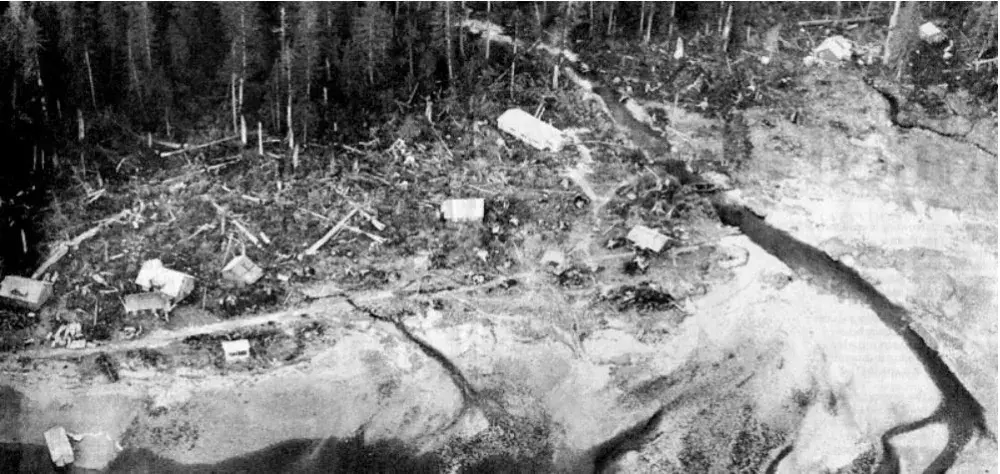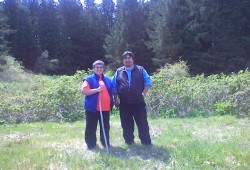It’s been 60 years since the Hesquiaht village of Hot Springs Cove was struck by a late-night tsunami that left most of the residents homeless in its aftermath, but survivors are grateful that no local lives were lost as they reflect on memories of that terrifying night.
On March 27, 1964, a 9.2 megathrust quake shook Alaska at 4:36 p.m. Known as the Great Alaska Earthquake and the Good Friday Earthquake, it was the second largest earthquake on modern record and the largest ever in North America. The quake sent damaging waves across the Pacific Ocean and down the North American coast as far south as California and west toward Hawaii and Japan. Back then they were called tidal waves. Today they are known as tsunamis.
Over the years Ha-Shilth-Sa has shared the stories of many Nuu-chah-nulth survivors that witnessed the tsunamis that struck in Hot Springs Cove and Port Alberni.
Hesquiaht mother and son, Dolores Bayne and Ha’wilth Vince Ambrose, shared what they remember from that night in 1964.
“We were having dinner and someone outside was yelling, ‘Get out! Run to the hills!’,” said Ambrose, who was five years old at the time.
Dolores recalled that it was Good Friday and she had been ironing clothes for Easter Sunday church services, while her husband Billy Ambrose was eating at the table with their younger children, Vince, Marion and Rose. Their older daughter, Doreen, was at Christie Residential School on Meares Island.
According to Dolores, her husband had salvaged an abandoned house from nearby Muchasnit and towed it to the village to fix it up for his family to live in. At that time, they were living in Edward and Maude Jones’s house. The Joneses had moved to Port Alberni and allowed the Ambroses to use their house, which was on stilts on the west end of the head of the cove.
In 1964 the village was powered by generators, which were off by the time the tsunami struck. People that were still awake at 11 p.m. were using gas or oil lanterns for light.
Busy with her ironing, Dolores said she heard something at the open back door.
“I saw junk floating by and water running in,” she remembered.
Speaking in the Hesquiaht language, someone shouted the word for ‘tidal wave’.
“Their dad (Billy Ambrose) yelled to get the kids upstairs, and I thought we might even have to go on the roof,” said Dolores.
On the way upstairs, the children were dressed in boots and coats. When the water receded the family ran outside and headed for the hill on the west end of the village.
“I had baby Rose and Vince on one arm and their dad had Marion,” said Dolores.
At some point, Vince was handed over to Mike Tom Jr., who, at that time was a young married man with a baby girl. Mike had been running to the hill with his wife, baby and mother.
“They (the Toms) were carrying their mother and she fell…someone had to grab her by the hair to save her,” said Dolores.
On the way to the hill, the survivors had to cross what Dolores described as a channel of water, like a ditch, but with a fast-moving current.
“I slipped (and fell into the channel of water) and Mike grabbed me, saving me,” said Ambrose.
After fighting through bushes and branches in the pitch dark, the family made it to safety. The family joined Chief Ben Andrews, Hesquiaht Tyee Ha’wilth, and his wife Columba, where Jean Charleson lived.
“Jean put up a tarp and had blankets – she told us to put the kids under the tarp where her kids were,” said Dolores.
As the second surge of water receded, Billy Ambrose went back down to the house to retrieve blankets as Columba pleaded with him not to go.
“But the water came back up and he had to wait for it to recede,” Ambrose recalled.
From the safety of the hill, the family saw some of the village houses floating out into the cove as boats rushed to each one, looking for survivors.
“I saw a house floating with two people on the roof,” said Ambrose.
As the rescue boat pulled the surviving elderly couple Alex and Mary Amos to safety, the house burst into flames.
Dolores remembers seeing her uncle Matthew and aunt Mamie Lucas’ house going up in flames while Sylvester Charleson and David Charleson used a skiff to check for survivors in the houses that were floating away.
The survivors, children included, slept outside, under the tarp, huddled in blankets overnight. Jean Charleson comforted the survivors with food and hot drinks. Her house and one on the opposite end of the village were the only two of the 18 homes that escaped the tsunami unscathed.
The following morning, Ambrose recalls seeing his family home for the first time in daylight. The house had been built on stilts but the waves had knocked one side off.
“The next day Ahousaht boats came to pick us up,” Dolores recalled. “We stayed there for a few days after salvaging what we could.”
The house that her husband had attempted to salvage for the family had also been washed away in the tsunami. “All that hard work was gone,” said Dolores.
Sometime later, residents came back to the cove where they were met with boxes and boxes of donated food, clothing and household goods. “I think they were from Vancouver,” said Dolores, adding that the Ahousahts had donated kitchen ware.
“We moved into one of Ivan Clarke’s cabins,” she recalled.
Ivan Clarke owned the general store in Hot Springs Cove and his buildings were undamaged by the tsunami.
On March 27, 2024, Hesquiaht Chief Councilor Mariah Charleson, whose grandmother Jean worked so hard to comfort the children and other survivors, acknowledged the 60th anniversary of that terrifying night.
“The aftermath of the tidal wave and the sheer devastation of the village has impacts that last to this day,” she wrote.
Sending her love to all the survivors of the tsunami, Charleson stated, “We, as Hesquiahts, have been displaced many times throughout history due to Canada’s mandate to assimilate us (creation of reserves system, Indian Act, Residential “School” System). The tidal wave in 1964 was another cause of displacement that has lasting impacts on all Hesquiahts leading to many of our people to be further displaced from our territories that have sustained us since time immemorial. We are strong and intelligent people. We got through this traumatizing experience and we are still here as strong Hesquiahts.”
For both mother and son, the events of that night left long-lasting scars.
“It still chokes me up because Vince is here today…we could have lost him…and my grandmother and grandfather, we could have lost them,” said Dolores.
“This is why I react the way I do…whenever we get a tsunami warming, my mind goes into high gear,” said Ambrose.


